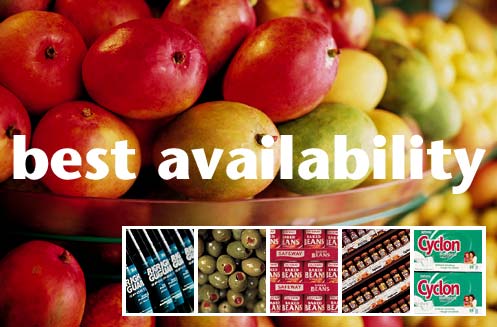
| Our availability continues to improve: | |
| – | We are currently achieving 99% ambient availability and have reduced ambient out-of-stocks by 13% during the year. |
| – | Our core fresh availability is now consistently over 96%. |
| – | Availability of our “hero” promotions on the front of the flyer is now regularly 99.5%, a significant improvement on last year. |
| – | Measured against the comparative data
on out-of-stocks at store level which regularly appears in The Grocer magazine,
we have achieved a major improvement in our relative performance. |
 |
|
| Ric Francis Chief Information Officer |
|
 |
|
| Lawrence Christensen Supply Director |
|
| we are currently achieving 99% availability |
Expanding the network
When our promotional strategy was first launched in the autumn of 1999, our initial response to the challenge of managing the supply chain was quickly to acquire satellite distribution centres to handle fast-moving promotional products. We also introduced a cross-docking process in our fresh depots, allowing us to achieve a faster turn-around of fresh product on promotion. We are now building a long-term, integrated solution tailored to the specific needs of our business. During the last year, this has involved the following changes to our depot network:
- The opening of a new 300,000 square foot depot at Coventry to handle ambient
and fast- moving products. After only nine months in operation, this depot received
full accreditation as an Investor in People.
- The conversion of Welwyn into a fresh-only depot serving London and the South.
As part of the conversion, the facilities for our staff have been upgraded to
include a fully-equipped learning centre and briefing room.
- The extension of our depot at Willand, near Exeter, to include chilled lines
for our West Country stores.
- The extension of our frozen chamber at Warrington.
- The creation of a dedicated chamber in our Northampton depot to handle our growing volumes of non-food lines.
Since the end of the year, the whole of our Supply Division – including supply chain, central logistics and in-house depots – has been accredited as an Investor in People. This recognition also extends to the way in which we work with our third party depots, the first of its kind in our industry.
Transport
We have introduced a satellite tracking system for our 1,600 trailer units so that we can more easily pinpoint their exact location and also ensure that we have the right profile of trailer fleet on each depot site and that they are being fully used.
Forecasting and ordering
The increasing sophistication and local focus of our promotional strategy has meant that store
management teams are now able to fine-tune the central forecast on fresh sales to meet the particular needs of their store. We have also developed a reactive algorithm which adjusts orders in the light of the pattern of sales in the first part of the promotional week. Suppliers now have more direct control over the progress of their products through our Supplier Information System. This gives them quick access to a database which identifies the size and location of any mismatch between supply and demand. Suppliers are now using this database up to 10,000 times a week. Improvements such as these have helped us manage key seasonal changes in sales volumes more effectively and achieve the best-ever levels of availability in stores.
Integration with suppliers
During the year we achieved a big improvement in supplier lead times. Negotiations with over 500 suppliers have resulted in a reduction in average lead times from six days and three deliveries a week to three days and five deliveries. Our top 20 suppliers will shortly be making seven deliveries a week on 24-hour lead times.
Moving upstream
Just-in-time delivery integrates our suppliers more closely into our business. Conversely, we are also taking more control of the distribution chain by moving towards “factory gate” pricing. Under this system, a supplier offers us two prices – one including delivery to our depots, the other based on pick up at the factory by our own vehicles. This enables us to achieve substantial cost savings by using our own fleet more intensively while reducing the total number of “food miles” involved in the supply chain.
Wastage
A big risk with any rapidly-changing promotional programme is that product wastage levels will increase. In fact, as a result both of the changes described above and many others across the business, we achieved a 40% reduction in wastage as a percentage of sales.
This year
Our goal is to build on last year’s performance by taking more control of the upstream
supply chain, particularly from distant foreign markets, and moving to factory gate pricing with more suppliers.
 |
 |
 |
 |
 |
 |
|||||
 |
 |
 |
 |
 |
 |
|||||
 |
 |
 |
 |
 |
 |
|||||
 |
 |
 |
 |
 |
 |
| © Copyright 2002. Safeway plc. | Top | Previous | Next |